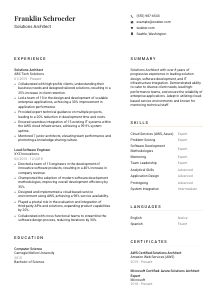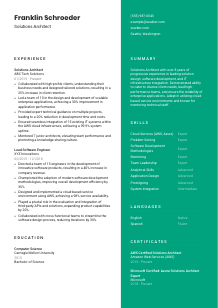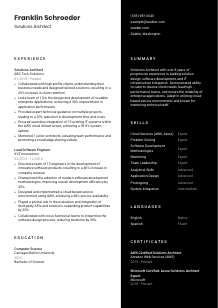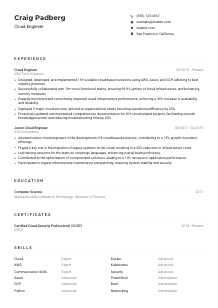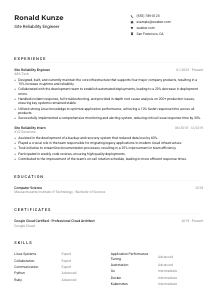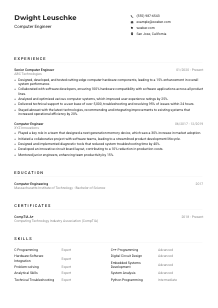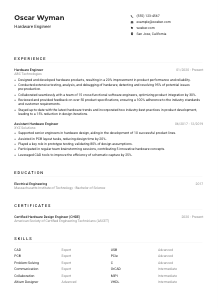Solutions Architect Resume Example
Crafting tech solutions, but feeling stuck on the structural drafting? Delve into this Solutions Architect resume example, edified with Wozber free resume builder. See how straightforward it is to blueprint your architectural acumen to align with job specifics, paving a career path as elegant and functional as your system designs!
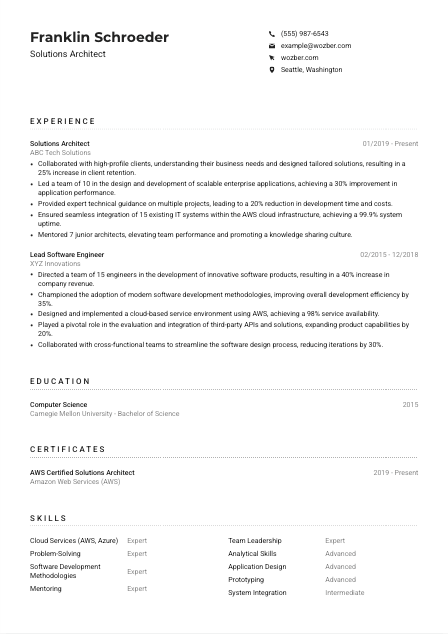
How to write a Solutions Architect Resume?
Hello, aspiring Solutions Architect! Ready to build a resume that not only showcases your architectural prowess but also sails smoothly through the ATS and lands in human hands? You're about to embark on a journey that not only satisfies the job requirements but positions you as the perfect fit for your dream role.
Dive deep with us into the art and science of writing a compelling Solutions Architect resume, fortified with tips from Wozber's free resume builder, ATS-friendly resume templates, and ATS resume scanner. Let's blueprint your success!
Personal Details
The Personal Details section is where you lay the foundation. Think of it as your digital handshake. For the Solutions Architect role, precision and professionalism are key. Here's how you ensure your introduction is as sharp as your architectural solutions.
1. Showcase Your Identity
Your name is the masthead of your professional story. Embolden it with a clear, ATS-friendly font, setting the stage for what's to come. This is where you assert your identity as a Solutions Architect.
2. Job Title Alignment
Positioning "Solutions Architect" prominently below your name immediately flags your resume for relevancy, echoing the language of the role you're eyeing. This strategic alignment signals to the ATS—and the hiring manager—that you're in sync with their needs.
3. Crucial Contact Info
Your phone number and professional email are gateways for potential connections. Ensure they're error-free. Using a firstname.lastname@email.com format demonstrates professionalism and helps keep your application straightforward.
4. Location Matters
Given the role's requirement for someone based in "Seattle, Washington," spotlighting your Seattle location confirms your logistical suitability. It's a subtle nod to your readiness and relevance for the position.
5. Digital Professional Presence
A LinkedIn profile or personal portfolio website can bolster your application. Ensure these platforms reflect your resume's content, offering a cohesive narrative of your professional journey.
Takeaway
Crafting the perfect Personal Details section means you're ready for that professional handshake. Remember, simplicity coupled with strategic information placement sets the stage for your success. Your presence, both physically and digitally, must align with the role's requirements, readying you for that first impression.





Experience
As a Solutions Architect, your experience section is your portfolio. Here, you meticulously curate past projects and roles that reflect your architectural acumen. Think of it as your professional gallery, showcasing your masterpieces.
- Collaborated with high‑profile clients, understanding their business needs and designed tailored solutions, resulting in a 25% increase in client retention.
- Led a team of 10 in the design and development of scalable enterprise applications, achieving a 30% improvement in application performance.
- Provided expert technical guidance on multiple projects, leading to a 20% reduction in development time and costs.
- Ensured seamless integration of 15 existing IT systems within the AWS cloud infrastructure, achieving a 99.9% system uptime.
- Mentored 7 junior architects, elevating team performance and promoting a knowledge sharing culture.
- Directed a team of 15 engineers in the development of innovative software products, resulting in a 40% increase in company revenue.
- Championed the adoption of modern software development methodologies, improving overall development efficiency by 35%.
- Designed and implemented a cloud‑based service environment using AWS, achieving a 98% service availability.
- Played a pivotal role in the evaluation and integration of third‑party APIs and solutions, expanding product capabilities by 20%.
- Collaborated with cross‑functional teams to streamline the software design process, reducing iterations by 30%.
1. Matching Job Requirements
Start by dissecting the job description. Highlight the responsibilities and accomplishments in your career that reflect those sought in the job ad, like designing tailored solutions or leading development teams.
2. Role and Context Clarity
For each position, clearly list your title, company, and tenure. This structure not only feeds the ATS with consistent data but also provides a clear trajectory of your growth and expertise as a Solutions Architect.
3. Quantifiable Achievements
Accomplishments, quantified by metrics like "increased client retention by 25%" or "improved application performance by 30%," offer tangible evidence of your impact. These figures translate your efforts into results, speaking volumes to hiring managers.
4. Relevance is Key
Focus on experiences that resonate with the Solutions Architect role. Extraneous achievements, while impressive, can dilute the potency of your application. Keep every bullet pointed and laser-focused on what matters most.
5. The Language of Solutions
Use industry-specific language that mirrors the job description, such as "solution design," "cloud-based service," or "system integration." This not only demonstrates your expertise but also optimizes your resume for ATS scanning.
Takeaway
Your experience section is where you demonstrate you're not just a participant but a pacesetter in your field. Tailor your accomplishments, speak the industry's language, and make every word count. Remember, in the gallery of your professional exploits, you want each exhibit to captivate and engage the viewer—your future employer.
Education
In the realm of Solutions Architecture, your education isn't just about degrees; it's a testament to your foundational knowledge and conceptual understanding. Crafting this section with clarity and relevance can significantly bolster your application.
1. Highlight the Necessary Credentials
Starting with the basics, ensure your education aligns with the job requirements. For instance, a "Bachelor's degree in Computer Science, Engineering, or a related field" directly echoes the role's prerequisites.
2. Structure and Simplicity
Organize your educational background by degree, field of study, institution, and graduation year. This neat format is not only ATS-friendly but also allows for an at-a-glance comprehension of your academic profile.
3. Degree Specificity
If your degree directly complements the job, as with a Bachelor of Science in Computer Science, make it prominent. Tailoring your educational qualifications to the role can significantly leverage your application.
4. Relevant Extras
Though not always necessary, highlighting relevant coursework, honors, or extracurriculars can add depth to your academic profile, especially if they directly relate to the Solutions Architect domain.
5. Continuous Learning
In a field as dynamic as Solutions Architecture, ongoing education—whether through workshops, seminars, or additional certifications—shows a commitment to staying at the forefront of technological advancements. Mentioning these can add an extra layer of appeal to your profile.
Takeaway
In shaping your education section, align it closely with the role's requirements and showcase any additional learning that positions you as a contender in evolving technological landscapes. Your academic background is not just a list; it's the bedrock of your expertise and a promise of potential.
Certificates
In the domain of Solutions Architecture, certifications not only complement your academic and professional experience but also vouch for your specialized knowledge and commitment to your craft. Here's how to strategically present them in your resume.
1. Selecting Relevant Certifications
Prioritize certifications that directly align with the job's requirements or the industry's demands, such as the "AWS Certified Solutions Architect" or "Microsoft Certified: Azure Solutions Architect Expert." This alignment showcases your dedication and relevancy.
2. Highlighting the High-Value Certifications
While a lengthy list of certificates is impressive, emphasis on those most pertinent to the Solutions Architect role will capture the hiring manager's attention more effectively. Quality trumps quantity here.
3. Validity and Dates
Ensure to include the acquisition or expiration dates of your certifications, especially for those that require renewal. This maintains transparency and showcases your initiative in keeping your skills up-to-date.
4. Ongoing Learning
In a swiftly evolving field, continuous skill enhancement through certifications is crucial. Indicating recent or ongoing certification endeavors can illustrate your commitment to professional growth.
Takeaway
Strategically selected certifications have the power to significantly elevate your resume. By focusing on relevance, recency, and rigor, you position yourself as a Solutions Architect committed to excellence and continuous improvement. Let your certifications speak to your dedication to staying at the leading edge of technology.
Skills
The Skills section is your professional toolkit, outlining the technical and soft skills you bring to the table. For a Solutions Architect, this section is critical—it's where you prove you have the right tools for the job.
1. Skill Requirement Mapping
Extract both explicit and implicit skills from the job description. Matching your skills to the job's needs, such as "Cloud Services (AWS, Azure)" or "Strong Analytical and Problem-Solving Skills," directly speaks to your suitability for the role.
2. Prioritizing Pertinent Skills
In a landscape as vast as Solutions Architecture, it's essential to prioritize. Focus on the skills most relevant to the role and the ones where you excel. This tailored approach demonstrates strategic thinking and self-awareness.
3. Clarity and Conciseness
Each listed skill should be a beacon of your capability. Avoid overstuffing this section with every skill you possess. Instead, curate a list that resonates most strongly with the Solutions Architect role, ensuring clarity and impact.
Takeaway
Your Skills section is a testament to your professional prowess. Approach it with precision, selecting skills that not only match the job description but also set you apart as a Solutions Architect. This distillation of your abilities into a carefully curated list ensures you're seen as the perfect tool for the job.
Languages
In today's global business environment, being multilingual can be a significant asset. For Solutions Architects, this can mean the ability to communicate effectively with international teams or clients. Here's how to weave your linguistic capabilities into your resume.
1. Matching Job Language Requirements
Firstly, ensure you meet any specified language requirements, as with the mandatory "English language skills" for the Solutions Architect role. Highlighting your proficiency in these required languages affirms your eligibility.
2. Ranking Languages by Proficiency
List languages in order of proficiency. Starting with English as a native or fluent language, followed by any additional languages, indicates a breadth of communication skills valuable in diversified environments.
3. Displaying Additional Languages
Even if additional languages aren't specified in the job description, showcasing these skills can set you apart, illustrating versatility and the ability to navigate multicultural settings.
4. Honest Proficiency Levels
Be truthful about your language proficiency levels. Whether you're fluent, intermediate, or possess basic skills, clear communication about your abilities sets the right expectations.
5. Understanding the Role's Global Scope
For roles with international exposure, highlighting your linguistic skills could be a distinguishing factor. While not directly related to the core Solutions Architect responsibilities, they enhance your professional profile.
Takeaway
Your language skills are more than just a personal achievement; they're a professional asset that underscores your ability to engage in diverse work environments. While ensuring compliance with job requirements, also celebrate your multilingual capabilities as part of your unique professional identity. They are the subtle nuances that enrich your resume and professional narrative.
Summary
A compelling Summary captures the essence of your professional narrative. For a Solutions Architect, it's your chance to zoom out and present a holistic view of your expertise, weaving your skills, experience, and ambitions into a cohesive snippet.
1. Digesting the Job's Core
Begin by fully absorbing the job description. Understand the broader goals and challenges of the role to tailor your summary in a way that speaks directly to those aspects.
2. Starting with an Engaging Introduction
Kick off your summary with a dynamic statement that encapsulates your professional identity as a Solutions Architect. Mention your overarching expertise and how it aligns with the role's demands.
3. Tailoring to Key Requirements
Incorporate a shorthand list of your most relevant skills and accomplishments. Highlight your experience with "leading solution design" or "software development methodologies," directly tying your capabilities to the job at hand.
4. Conciseness is Key
Aim for brevity with impact. Your summary is the appetizer, not the main course. Craft a punchy introduction to your professional narrative that invites the reader to dive deeper into your resume.
Takeaway
Your Summary is the billboard of your professional journey. Make it bright, bold, and brief. By closely aligning it with the job's essentials and proudly presenting your Solutions Architect identity, you're not just another applicant—you're the applicant. Let your summary leave a lasting impression that begs for a deeper exploration of your credentials.
Launching Your Solutions Architect Journey
By now, you're armed with a blueprint for crafting a Solutions Architect resume that not only ticks the boxes but also tells a compelling story of who you are professionally. Each section of your resume is a stepping stone towards your goal. Utilize Wozber's free resume builder, ATS-friendly resume templates, and ATS resume scanner to ensure your resume isn't just seen but also appreciated.
Your journey as a Solutions Architect is ready to ascend to new heights. Let your resume be the launchpad.

- Bachelor's degree in Computer Science, Engineering, or a related field.
- Minimum of 7 years of experience in IT, with at least 3 years focused on solution design and architecture.
- Proficiency in software development methodologies and cloud-based service environments, particularly AWS or Azure.
- Strong analytical and problem-solving skills, with a customer-oriented mindset.
- Relevant certifications in solution architecture, such as AWS Certified Solutions Architect or Microsoft Certified: Azure Solutions Architect Expert.
- English language skills are mandatory.
- Must be located in Seattle, Washington.
- Collaborate with clients to understand their business needs, technical requirements, and design tailored solutions.
- Lead the design and development of scalable, high-performance, and reliable enterprise applications.
- Provide technical expertise in software design, prototyping, and solution proposals.
- Ensure the consistency and integration of existing and future IT systems within the infrastructure.
- Mentor and provide guidance to other technical staff on best practices and emerging technologies.





